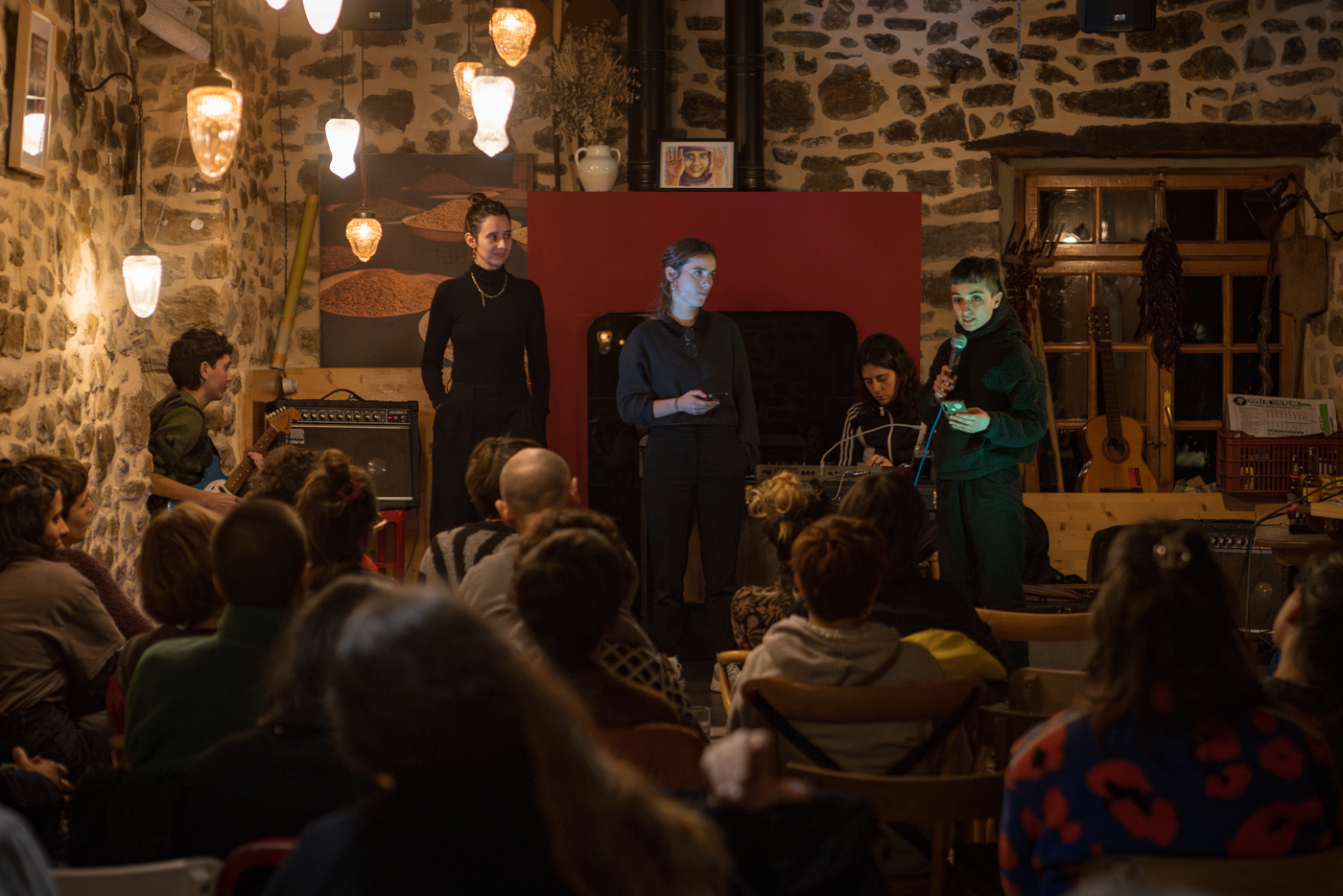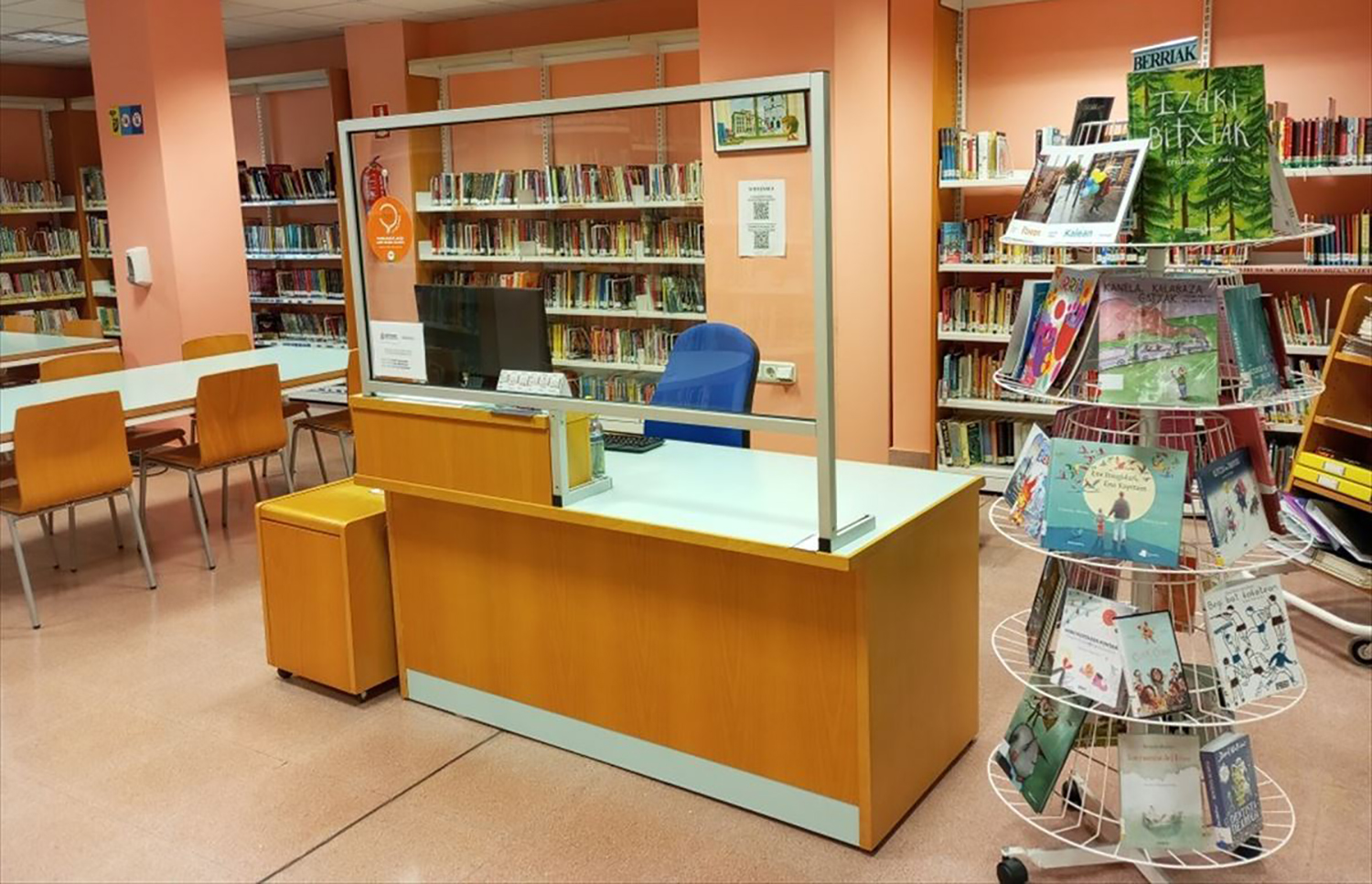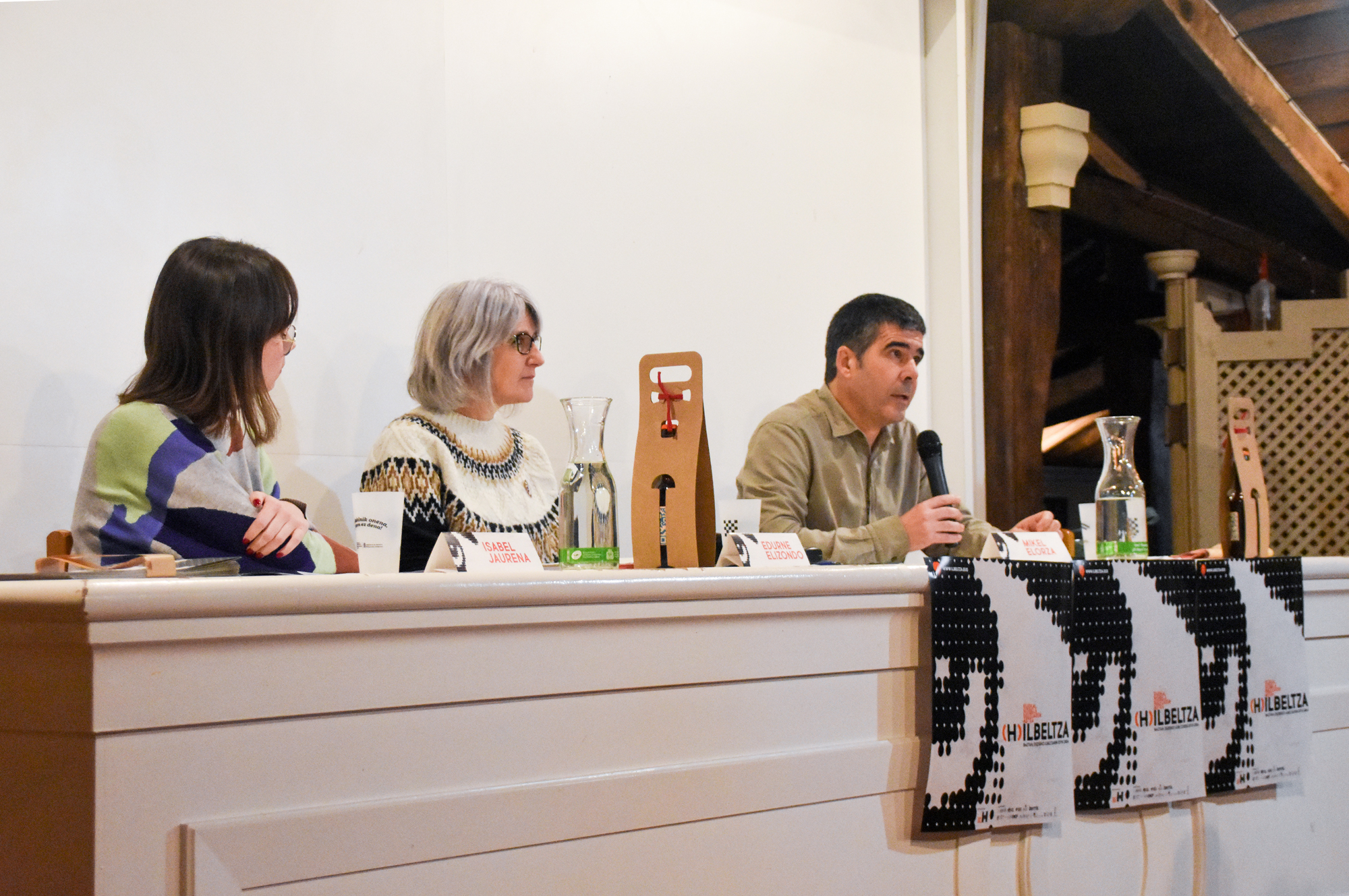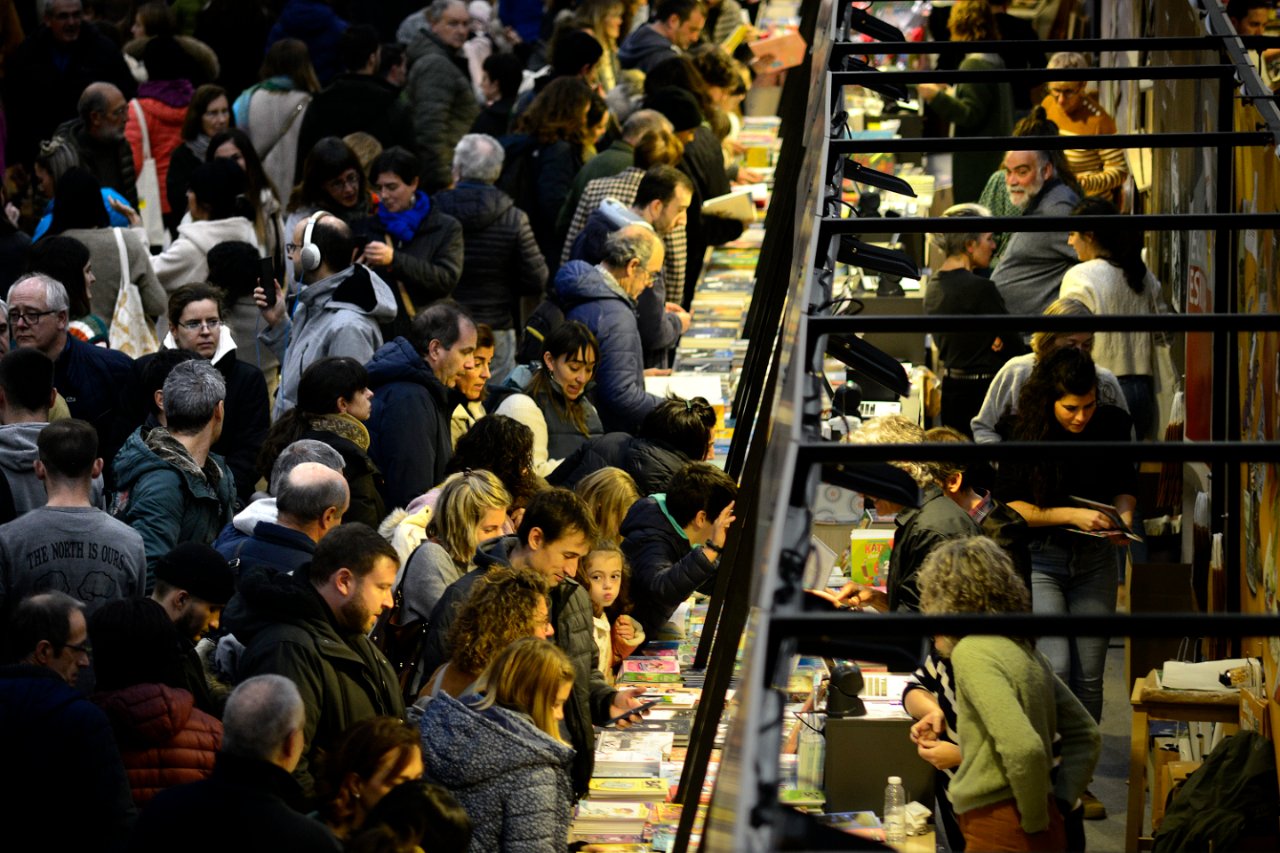"Without ellipsis wouldn't be my novel."
- Bergara 1964. Professor at the Instituto Navarro de Euskarabidea. Historian and journalist. The writer has gone to the literature square with a novel entitled The Trade Shows (Susa). We've seen it through social media, with the suitcase and the cocktail in our hands. These two components, the suitcase and the cocktail, occupy a prominent place in the book. It has brought some “new” words. For example, holidays. Asked about his origin, Patxi Larrion has offered us a word from his portfolio: I am from “Mugiro”. I mean, where there's a very intense environment.

I would say it was a surprise to go out into the street as a novelist and realize that you were born in Bergara.
Bergara is about the book. Our parents went to work at Bergara before we were born; they were from the town of Etxabarri, in the Allin Valley of Urbasa. From Etxabarri we have made many trips to Bergara, by train. We were departing from Estella and arriving to Bergara – passing through Zumarraga or returning to Vitoria-, one of those trains was La Vasconavarra, which disappeared in 1968. Sometimes an uncle approached Estella to take the train or took us to Etxabarri to the
vuelta.La Vasconavarra was closed at the time the holiday is set. Parents decided to buy a car and we went through Urbasa often. So I had fun with Urbasa. The first memories I have of Etxebarri are those of the year in which the movie Patton was playing: aitatxi-amatxi, uncle, aita and ama, talking about the movie they were making in Urbasa. Later, when they saw the images in the film, they told us exactly where “that place and the other” were.
So, from a young age you learned about the cinema, not the screen.
Yes. I've joined Urbasa and the movies since I was a kid. I remember reading the following on my way to Etxabarri: Filming. In addition to Patton, they also shot scenes from The Three Musketeers, Cromwel and Robin and Marian in Urbasa. Our cousins and their friends participated in these cases as extras.
Many consider childhood as their homeland. Your homeland appears to be in and around Urbasa.
Not in Pamplona, at least. I'm from Bergara and I feel like Etxabarri, my father's and my mother's people. I still have aunts and uncles in the Allin Valley. I have family and friends of childhood, also in Gipuzkoa. I breathe in the Allin Valley and also in Bergara. You know the joy of the presentation of the novel in Bergara! Anyway, most of all, I am from the place where it is “moving.” I’m pleased with “Mugiro.” If we know the details of the main protagonists, Martín and Luis, we see what is “modestly”.
“The three Musketeers, the scenes of Cromwel and Robin and Marian were also shot in Urbasa. Our cousins and their friends participated as extras in these cases.”
The novel unfolds in the city, but it's also very mountainous.
However, I wanted to show the mountain or the rural world in a different way. In Euskal Herria and also in the world, the mountain has been transmitted to us as an isolated place. In the literature, the mountain has always joined the isolation: as if they were bordering places. On the contrary, for me the Allin Valley or Mount Urbasa are exactly the opposite, they have been meeting places.
You have put an eye-catching title to the novel: Trade shows.
The word “feriatu” has been used mainly in Spanish, and from now on, I hope it will also be used in Basque. The “Feria” has been used mainly in the center of Navarra, it is “agenciar”, get it. It has not been stolen on its own, but it can and can be buy. The editor and others accepted my word. I've been helped by the various fairs that I heard around my family when it comes to creating the novel.
The protagonists are Martin and Luis, the trade shows. Explain to us the
novela.En against what some have said, I think the novel is more than a “holiday” of two young people, which goes beyond adventure. In this sense, the film Patton is the proverb of the novel. My effort has been to show the atmosphere of the end of Franco, including a reflection on carlism. At the same time, it is a political and economic novel. The plot is built around an exchange of money. Some supposedly weak steal others who are strong, the elderly, ferment them, but for that they have to be fast and count on the help of the strongest.
It was very clear that the priority would be the plot, it is told by the eyes of Martin, he is present in all the scenes. Within that, I wanted to tell the reader the end of the plot as it occurs in the cinema. That those who defeated in the war do not know who has deceived them. I wanted to get what's usually key in the movies I wanted to get. In it, there is a puzzle composition work, in which Martin is in charge of joining the pieces. The plot is the most important, but not everything is for her, as history also has weight in history.
You've known the story. But you've also been in the week of the black novel Baztango (H)ilbeltza. Do you have the Trade Shows as a book of that kind?
(H)ilbeltza is an act in which we find several people from Pamplona, including Jon Alonso and I. The organizers, I think of them as partners, and when they proposed to participate in it, I said, "Is this black?" ". Because I had not appeared dead in the novel, I had not even wanted blood. (H)Ilbeltza was Miel Angel Elustondo, who spoke about the novel of Gotzon Garate. “A dead novel, can it be black?” I asked. I was reassured that he said “no doubt.”
“For me in the novel there are no manqueisms, I have told some fairs. In the story, one character does not rise and another is humiliated”
There is no blood, but wine and food are very quiet.
The protagonists of the novel drink and eat very well, but without passing. Or not even to think about what a poor reader said to me: “Your novel is the apology of speed.” No, under no circumstances. Martin needs gasoline, fairers need adrenaline. Martin doesn't know how to stand. Passion, how do you keep it without adrenaline? The two protagonists of the novel sleep little, as we do in the Sanfermines. For holidays you have to walk fast and fast, as well as to maintain the march of Sanfermin.
Aunt Irene said: "Early or newcomer? he says to his nephew Martin. Luis and he are a pair of cuckoo birds?
Martin and Luis come together. Very different. They are capable of the second, at the same time that they study in the School of Journalism. Luis is from Malaga and Martín de Améscoa, also from a well-settled family. Luis de Pamplona is who, his family, his father, but also Martin. Martin Galdeano's personality is in the Allin Valley, which I know well, its character is native. Amatxi, my mother's mother, was from Aranarache, near Eulate. These valleys are quite endogamic, most of them landowners, even if they are small, and the one with little land has used communal lands. In the 1950s, the industry was strengthened in the Gipuzkoa area, and some of the families worked in Gipuzkoa.
The plot also takes place in the region of Pamplona, Urbasa and Ultzama. In the novel you have brought Euskera abundant and animated.
It is a unified Basque, I have written it in a unified Navarro, I have used the twenty-five characteristics that the Navarro has in common. Jon Alonso often says, “Larrion is a word smuggler.” The word “trade shows” is just one example of this. I have moulded the Spanish language in Pamplona, but I have made no effort. I say it in a single “swallow”, in a “clicol”. It will never appear in the dictionary, but I have been accepted in the novel. These are words that are in my suitcase, I've pulled them out of my portfolio, which I have the closest. I have made no effort, I have not wanted to surprise anyone. And the same with place-names. These names do not bother the novel; on the contrary, they give a certain closeness to the story.
You've prioritized character conversations.
I wanted to bring the interviews as if they were from a movie, as if they were movie scenes. I've given importance to interviews or tried to do so. Did I get it? Readers have to say that.
I’ve heard many times “I’ve started and I’ve finished.” It's no small thing. The photojournalist Gari Garaialde in a tweet “I am with the protagonists of the novel Martin and Luis, are they going to get it?”. Do you know what I was happy about? I do not know if you liked it after all, if you have still done something, very well.
The novel has been criticized...
Actually, this novel is male, and for contrast I introduced two strong women, Irene and Gisèle. Since Gisèle appeared, the novel has risen, Aunt Irene’s role is also key.
Most criticisms come from the profile of these two women: "Wasn't there another woman in 1969? Were they all raised or sluts?” OK. But to tell what I meant, I needed the characteristics of those two women.
“The holiday word has mainly been used in Spanish, and now I hope it will also be used in Basque”
In a critique we read the “Manichaism between good and bad characters.”
Martin and Luis are dear, but also Salbatore and Pedrotxo, even if they are from other sides. For me there is no Manicheism, I have told some fairs. In the story, you don't step up to one character and humiliate another.
Being your first novel, where have you found more obstacles?
We've had to cut at the time of editing, sacrifice some characters, adjust the role of some... On the other hand, we debate between fiction and history to which we give more space. Well, it's clear to me what the novel's winner is: fiction. At the heart of the novel, there's a lot of documented work, even if it's to tell lies.
You've written history without giving up the tendency to ellipsis.
According to his colleague Pello Lizarralde, “Patxi Larrion’s activity is marked by ellipsis.” Those of you who know me know that it's my way of expressing it. I need ellipsis, and in the novel probably this feature is very present, it's a style that goes by itself. The style of the ellipsis must be dominated very well, of course, and perhaps I have not succeeded, I recognise that it can be a hindrance, but without ellipsis it would not be a novel by Patxi Larrion.
Patxi Larrionen ibileren berri izan dugu sare sozialen bidez. Bergara, Durango, Txantrea, Larrabetzu eta Arizkunen ibili da Feriatzaileak defendatzen. Xabier Letona ARGIAko kazetariak horrela idatzi du Twitterren: “A ze lanak eta pozak ematen dituen maleta horrek Euskal Herrian barrena, aurkezpenetik aurkezpenera!”.
Horrek guztiak sormen prozesuarekin badu zer ikusirik. Gustura pasatu dut nobela idazten eta berau defendatzeko prest nago, deitzen didaten tokira joateko gogotsu. Liburuaren promozioan bi elementu nagusi izan dira: maleta eta koktela. Koktelaren historiak badu zerikusia idazte prozesuarekin. Trama jada nahiko aurreratua nuenean, lagun batek garai bateko notizia hau pasa zidan: “Patton koktela hirugarrena geratu da, Nafarroako Kokteleria txapelketan”. Miguel Lizarbe barmanak prestatu zuen koktelaz ari zen. Patton filmeko aktoreak nahiz teknikariak Maisonnave hotelean ostatu hartzen zuten garaikoa. “Hara, badut nobelaren hasiera!” pentsatu nuen. Koktelgile lagun batek berritu zuen koktela, eta esan nuen, sikiera, liburuaren aurkezpen egunean neronek ere prestatuko dut. Gero irakurle klubetan eskatu didate, eta aurrera. Bergaran eta Arizkunen eginez gero, bestetan ez dira gutxiago izango, ezta?
Liburuaren azalean ageri den maletak ere badu bere historia, berriagoa izan arren.
Maletak eman du joko gehien. Maleta ez, maletak, bi baitira, badute leku berezia nobelan. Argitaletxeak maleta eskuratu zuenean, azala egin ondoren, “zergatik ez diot eskatzen, azala egin duen Xabiri?” pentsatu nuen. (H)ilbeltza taldeko partaidea da. Azalean agertzen den irudiaren afixa ere badago, film baterako modukoa. Kristoren lana egin dute Susako lagunek. Batzuetan erabiltzen dut, ezusteko politak izaten dira.
Irakurle izatetik idazle izatera pasa zara. Zer-nolako esperientzia izan da emandako jauzia? Zerbaitek harritu al zaitu?
Beste aldera pasatzea suertatu zait, baina nik mundu hau ezagutzen nuen. Harritu ez, poztu bai. Batetik, poztu naiz jende asko nobelarekin identifikatu delako. Badago bestela pentsatzen duenik ere, noski, adibidez, nobelan leku eta kale izen gehiegi azaltzen direla diotenak. “Horiek kontakizunari edota tramari traba egiten badiete, kentzeko prest naiz” esan nion editoreari. Ezetz esan zidan. Iruñea ezagutzen dutenei, eta ez bakarrik bertakoei, balio erantsi bat eman nahi nien, uneoro jakin zezaten nondik barna zebiltzan protagonistak. Beste batek esan dit, “nik ezagutu nuen garai horretaz beste ikuspegi bat emango nuke”. Batzuetan ahalegintzen zara egoera bat transmititzen, pertsonaien harremana dela medio, eta argi dago ez duzula pertsonaia denekin lortzen, baina uste dut gehienetan lortu dudala nahi nuena transmititzea. Ahalegindu naiz sikiera. Orain plazer handia hartzen ari naiz irakurleekin hori partekatzen.
Joan Tartas (Sohüta, 1610 - date of unknown death) is not one of the most famous writers in the history of our letters and yet we discover good things in this “mendre piece” whose title, let us admit it from the beginning, is probably not the most commercial of the titles... [+]

















ilbeltza-(1).jpg)




